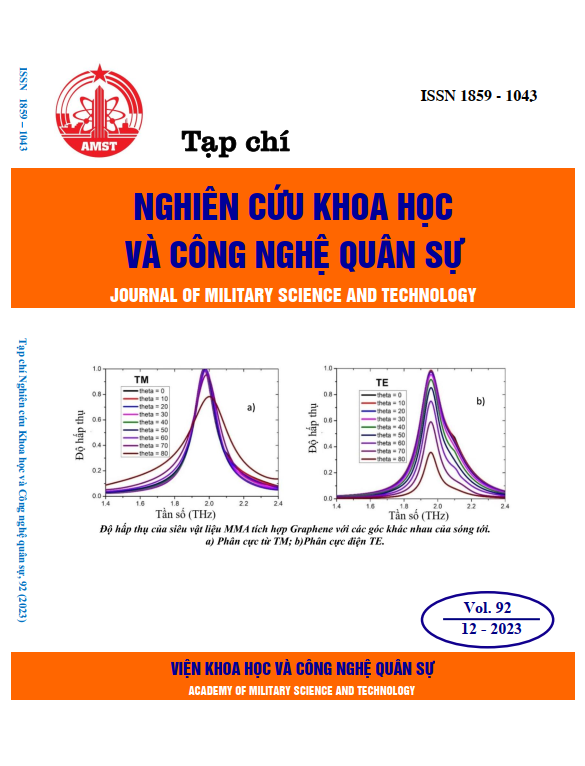Synthesis of TiO2/carbon aerogel composite and its photocatalytic degradation of gaseous formaldehyde
417 viewsDOI:
https://doi.org/10.54939/1859-1043.j.mst.92.2023.63-70Keywords:
Photocatalyst; TiO2/Carbon aerogel; Formaldehyde treatment.Abstract
In this study, TiO2 was modified with carbon aerogel (CA) derived from organic polymer to form a photocatalyst material to remove formaldehyde vapor in the air. TiO2/CA samples were synthesized under different calcination temperatures and different TiO2 and CA ratios by sol-gel method. Modern methods like scanning electron microscopy(SEM), Energy Dispersive X-Ray Analysis (EDS), Powder X-ray diffraction (XRD), N2 adsorption-desorption isotherm were used to analyze surface morphology, crystal structure, and surface area characteristics. The results indicate that TiO2 with CA modification enhances surface area and minimizes clumping in synthesis. The formaldehyde vapor treatment test was performed with 0.1g of the catalyst dispersed on the surface with dimensions of 5 ×20 cm under UV lamp (365 nm, 36 Watts), gas flow 1.5 l/min. The highest efficiency of the TiO2/CA sample was about 61% compared with 49% of the pure TiO2 sample.
References
[1]. N. Đ. Nghĩa, “Polyme chức năng và vật liệu lai cấu trúc nano”. (2008).
[2]. J. Moma and J. Baloyi, “Modified Titanium Dioxide for Photocatalytic Applications”, Photocatalysts: Applications and Attributes, pp. 37–56, (2019). DOI: 105772/intechopen.79374. DOI: https://doi.org/10.5772/intechopen.79374
[3]. R. Jaiswal et al “Copper and Nitrogen co-doped TiO2 photocatalyst with enhanced optical absorption and catalytic activity,” Appl Catal B, vol. 168–169, pp. 333–341, (2015), DOI: 10.1016/j.apcatb.2014.12.053. DOI: https://doi.org/10.1016/j.apcatb.2014.12.053
[4]. M. Alsaiari, “Biomass-derived active carbon (AC) modified TiO2 photocatalyst for efficient photocatalytic reduction of chromium (VI) under visible light,” Arabian Journal of Chemistry, vol. 14, no. 8, (2021), DOI: 10.1016/j.arabjc.2021.103258. DOI: https://doi.org/10.1016/j.arabjc.2021.103258
[5]. M. Wu et al, “Electrosorption-nromoted photodegradation of opaque wastewater on a novel TiO2/carbon aerogel electrode,” Environmental Science and Technology, vol. 44, no. 5. pp. 1780–1785, (2010). DOI: 10.1021/es903201m. DOI: https://doi.org/10.1021/es903201m
[6]. J. Zhang et al., “A TiO2 coated carbon aerogel derived from bamboo pulp fibers for enhanced visible light photo-catalytic degradation of methylene blue,” Nanomaterials, vol. 11, no. 1, pp. 1–12, (2021). DOI: 10.3390/nano11010239. DOI: https://doi.org/10.3390/nano11010239
[7]. Ahmad Jonoidi Jafari et al, “Synthesis and Characterization of Ag/TiO2/composite aerogel for enhanced adsorption and photo-catalytic degradation of toluene from the gas phase,” Chemical Engineering Research and Design, vol. 150, pp. 1–13, (2019). DOI: 10.1016/j.cherd.2019.07.017 DOI: https://doi.org/10.1016/j.cherd.2019.07.017
[8]. “WHO guidelines for indoor air quality: selected pollutants.” Organization, W.H., (2010).
[9]. F. J. Sotomayor, K. A. Cychosz, and M. Thommes, “Characterization of Micro/Mesoporous Materials by Physisorption: Concepts and Case Studies”, Acc. Mater. Surf. Res. Vol.3 (No.2), pp 34-50, (2018).







